Trulshik Rinpoche
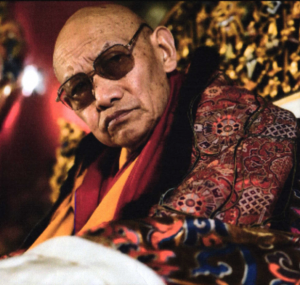
Kyabjé Trulshik Rinpoche Ngawang Chökyi Lodrö (Tib. འཁྲུལ་ཞིག་ངག་དབང་ཆོས་ཀྱི་བློ་གྲོས་, Wyl. ‘khrul zhig ngag dbang chos kyi blo gros) (1924-2011) was one of the seniormost lamas of Tibetan Buddhism. He was recognized as a reincarnation of the tertön Trulshik Dongak Lingpa who revealed the rare Dzogchen cycle of the Yangti Nakpo. First based on the northern slopes of Mount Everest in Rongpuk Monastery, a place affiliated to Mindroling Monastery, he was considered the heart son of both Kyabjé Dilgo Khyentse Rinpoche and Kyabjé Dudjom Rinpoche. He became a teacher to His Holiness the Fourteenth Dalai Lama, and in 2010 the head of the Nyingma school.
Birth, Family, Recognition
Born in 1924, in Central Tibet, in an old family of Dharma practitioners
Trulshik Rinpoche[1] was born in Central Tibet, in 1924, in an old family of Dharma practitioners. The family of his father, Tenzin Chödar, traced its ancestry to a member of the Licchavi clan of India, who was carried to Latö in Tibet on the back of the protectress Palden Lhamo, in the guise of a bear. The family of his mother, Jamyang Wangmo, descended from Önré Dharma Senge, nephew of Tsangpa Gyarepa, the great founder of the Drukpa Kagyü lineage. Trulshik Rinpoche’s family still inhabited Önre Dharma Senge’s house in the district of Nakartsé near Yamdrok Taklung in lower Tsang. It was there, in the cave where Önré Dharma Senge had practiced above the family house, that Trulshik Rinpoche was born on the 10th day of the ninth month of the Year of the Wood Rat (6 November, 1924), with many miraculous signs.
How his birth was predicted to the 10th Dzatrul Rinpoche
The birth of Trulshik Rinpoche was announced to the 10th Dzatrul Rinpoche, Ngawang Tendzin Norbu, who was among the three main students of Trulshik Dongak Lingpa. This happened in the following way. One day, after the passing away of his guru Trulshik Dongak Lingpa which happened in 1922, Ngawang Tendzin Norbu, the 10th Dzatrul Rinpoche , witnessed two flying sparks which he perceived to be coming from Zangdok Palri. One landed in a village near the seat of his master and the other landed in his very own lap. The obvious meaning to him was that there would be two incarnations of Trulshik Dongak Lingpa: one would be found in that village, and the other would be found by him and would be under his care. This is what transpired. The spark in the village became extinguished after only a short time, unlike the spark that came to him. Later, he understood that this was a foreshadowing that indicated that the incarnation in the village would not live long—because that is how things took place— whereas the incarnation which will come to his care, that of Trulshik Rinpoche, will have a long life, indicated by the bright, long-lasting light of the direct message from Zangdok Palri.
Being recognized as the tulku of Trulshik Dongak Lingpa by Ngawang Tendzin Norbu, the 10th Dzatrul Rinpoche
Based on these signs, in 1928, the 10th Dzatrul Rinpoche identified the child in of the village, and invited the then four years old Trulshik Rinpoche to visit him in Rongpuk Monastery, in the Shelkar district of Latö, in Central Tibet, on the northern slopes of Mount Everest. While Trulshik Rinpoche was there, memories of events in his previous life arose spontaneously in his mind. He recounted them at length, to the astonishment of the 10th Dzatrul Rinpoche who had witnessed those events with his own eyes. Convinced that the young boy was indeed the incarnation of Trulshik Dongak Lingpa, the 10th Dzatrul Rinpoche recognized and enthroned him. With their psychic abilities, many other realized masters, also recognized him at an early age as the tulku of Trulshik Dongak Lingpa[2].
Being part of an illustrious line of incarnations
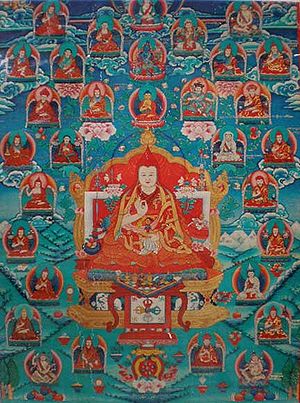
As is shown in the ‘Prayer to the Successive Lives of the Great Trulshik 'Destroyer of Delusion' written by the 10th Dzatrul Rinpoche—Trulshik Rinpoche's previous incarnations — Trulshik Rinpoche ‘s line of previous incarnations is illustrious. He is said to have had thirty previous incarnations as eminent Buddhist masters, thirteen of which were born in India, and seventeen in Tibet.
Training
Studying and receiving teachings and empowerments from over fifty masters
Throughout his life, Trulshik Rinpoche had over fifty masters representing all of the major lineages of Tibetan Buddhism. He undertook studies, beginning with grammar and continuing through Madhyamaka, Prajnaparamita, Vinaya, Abhidharma, and so forth. He received and studied in great detail many teachings on the sūtras, the tantras, and the various other branches of knowledge.
Studying with Ngawang Tendzin Norbu, the 10th Dzatrul Rinpoche
First, he studied and received his early education with the 10th Dzatrul Rinpoche — who was known as the Buddha of Rongpuk after his place of retreat and the monastery that he established on the northern slopes of Mount Everest. — his root guru, and one of the three main disciples of his predecessor. From him, he received all the teachings of his predecessor, Tertön Dongak Lingpa. At the tender age of ten, he took novice vows.
Studying in Mindrolling with Mindrolling Chung
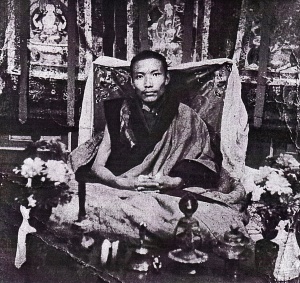
As Rongbuk was affiliated with Mindroling Monastery — a great seat of learning of the Nyingma tradition in Central Tibet— Trulshik Rinpoche went there and studied extensively.
Frist, from the great khenpo of Mindroling Monastery, Minling Khenchen Ngawang Khyentse Norbu, he received many teachings and transmissions of the Vajrayana, such as the commentaries on the Guhyagarbha Tantra, The Essence of Secrets Tantra.
There too, from the preceptors Minling Chung Rinpoche and Minling Khenchen Ngawang Khyentse Norbu, and from Gyurmé Chökyi Drakpa (the younger brother of the tulku of Mindroling Monastery), he received full monastic ordination, in the tradition of the great abbot Shantarakshita. He therefore took full monastic vows in the Vinaya ordination lineage descended from Lachen Gongpa Rabsal, of which he was considered one of the principal holders, renowned for his pure discipline. Pure in his moral conduct, Trulshik Rinpoche became in these later times a crown jewel for all those who uphold the monastic vows and the teachings associated with them.
About the times of Trulshik Rinpoche in Mindroling, Orgyen Topgyal Rinpoche shared the following story,
- Khochen Rinpoche told me that having agreed to visit Mindrolling Monastery, Jamyang Khyentse Chökyi Lodrö Rinpoche was received in the most elaborate style possible by all the lamas and monks, including Minling Khenchen Ngawang Khyentse Norbu and Minling Chung Rinpoche. From the great stupa, Rinpoche was escorted to the main temple, placed on the throne, and offered a mandala and the representations of body, speech and mind. He was then invited to the empowerment hall, where he granted the complete transmission of the Nyingtik Yabshi, The Four Parts of Nyingtik. Trulshik Rinpoche said Khyentse Rinpoche didn’t give the transmission of the Heart Essence of the Dakinis at that time, but Khochen Rinpoche always insisted that he gave the entire Nyingtik Yabshi (Khochen Rinpoche said Trulshik Rinpoche didn’t get the Khandro Nyingtik, The Heart Essence of the Dakinis, because he left early). Jamyang Khyentse Chökyi Lodro Rinpoche also gave Dungsey Rinpoche of Mindrolling, Khenchen Rinpoche, Chung Rinpoche, and a few tulkus the empowerments, reading transmissions and instructions for the Chetsün Nyingtik, and Jamgön Kongtrul’s The Drop that Embodies All Secrets, using Minling Khenchen’s commentary. [3]
Studying with Dordzin Rinpoche
Trulshik Rinpoche also studied with Dordzin Rinpoche.
Studying with Shuksep Jetsünma (aka Lochen Chönyi Zangmo)
Later, Trulshik Rinpoche went to Gangri Tökar to receive empowerments and teachings from the dakini Shuksep Jetsünma, aka Dakki Chönyi Zangmo, whom he regarded as the extraordinary master of his buddha family. [4] She transmitted to him several key cycles of teachings: The Flight of the Garuda of Shabkar Tsokdruk Rangdrol; the Nyingtik Yabshyi. He also painstakingly received from this dakini — and aslo from the 10th Dzatrul Rinpoche — the rare secret Dzogchen Yangti Nakpo, The Black Innermost Heart Drop, with instructions on the Tögal dark retreat, which became a very special lineage he held.
Until his passing, Trulshik Rinpoche was the only living master who had received the pith instructions on the sublime secret from Shuksep Jetsün Rinpoché.
Studying with Jamyang Khyentse Chokyi Lodro
In Lhasa, around the years 1956-1959, Trulshik Rinpoche established a connection with Jamyang Khyentse Chökyi Lodrö who had come from Kham to Central Tibet. From him, at Mindroling, he received the Lama Yangtik and Khandro Yangtik cycles. About the connection between Trulshik Rinpoche and Jamyang Khyentse Chökyi Lodrö, Orgyen Topgyal shared the following story,
- At Ngagpi Tsang in Lhasa, Dudjom Rinpoche said to Trulshik Rinpoche,”Tomorrow I will seek an audience with Dzongsar Jamyang Khyentse Chökyi Lodrö. We have corresponded many times, but I have never met him in person.”
- A book written in Minling Lochen’s own hand lay on Dudjom Rinpoche’s table and was either the Vima Nyingtik, The Heart Essence of Vimalamitra or the Zabmo Yangtik, The Innermost Heart Drop of Profundity.
“This is the heart jewel of all my wealth,” said Dudjom Rinpoche. “There is nothing more precious to me than this book, and tomorrow I will present it to Khyentse Rinpoche as a mandala offering.”
- Eagerly, Trulshik Rinpoche said that he too would like to meet Khyentse Chökyi Lodrö.
- “I cannot take you to see him myself,” replied Dudjom Rinpoche, “because I have too many questions to ask him. It would be better if you went alone at some other time.”
- Dudjom Rinpoche went on to describe Khyentse Rinpoche as the most highly realized master alive. Yet he steadfastly refused to take Trulshik Rinpoche to see him.
- Later, Trulshik Rinpoche went to Samdrup Podrang alone to meet Khyentse Rinpoche and to request a teaching so they would make a spiritual connection. Rinpoche agreed to the teaching but added, “I will not be giving any empowerments because I have made a vow.”
- Phala Drönyer Chenmo had been an acquaintance and benefactor of Trulshik Rinpoche for some time. He said he wanted Khyentse Chökyi Lodrö to perform a wealth protection ritual for him, and he suggested that Trulshik Rinpoche join him when he made this request. Rinpoche agreed to do the ritual, and at the appointed time, Trulshik Rinpoche found himself sitting at the head of a row of monks, and Rinpoche sat opposite on a low throne with his attendant monks on either side. Rinpoche was the chant master and also played rge cymbals, while a monk with a wispy beard (probably Lama Chokden) beat the drum. By midday, they had performed the sadhana for summoning-life and wealth three times. As they were about to start a fourth repetition, Rinpoche received a respectful summons from Pomda Tsang: his mother had fallen seriously ill.
- “I must go. I know the family well, and it would be entirely inappropriate for me not to respond to that request. They are generous benefactors,” he said. “I will return tonight to close the practice. In the meantime, accumulate the ritual.” Rinpoche returned just before dusk and said that although he had given an empowerment, commanded the spirits and the illness to leave the woman’s body, driven away by obstacles, summoned longevity, and done everything he possibly could, nothing had helped; Two days later, she passed away.
- One the wealth-summoning ritual had been completed, Rinpoche told Trulshik Rinpoche to leave one of his “gho” with the family, as they were an important connection for him.
- “La so”, replied Trulshik Rinpoche, but he had no idea know what a gho was.
- “I myself will leave my shirt here,” said Rinpoche. He removed this thick woolen jacket, then took off the silk Khamp shirt he was wearing, foled it neatly, and placed it in the family’s treasure chest. Only then did Trulshik Rinpoche realize that a gho was an article of clothing.
- During the entrustment of wealth ceremony, Rinpoche gave a long-life empowerment to members of Phalha Tsang and Drönyer Tsang. Surprised, Trulshik Rinpoche reminded Rinpoche that he had vowed not to give any empowerments.
- “A vow is a compounded phenomenon,” replied Rinpoche, “and like all compounded phenomena, eventually disintegrates.”[5]
Orgyen Topgyal also shared the following story,
- Trulshik Rinpoche visited Jamyang Khyentse Chökyi Lodrö again and again [in Lhasa, in the years 1956-1959], and on one occasion asked Rinpoche to consecrate a thangka depicting Durtrö Lhamo in a running posture. On the back of the thangka was written, “Painted by the father, Jigme Dorje, as an object of devotion for his son, Yizhin Ledrup.”
- “This is incredibly special!” said Rinpoche, as he blessed the thangka. “You must give it to me! I must have it at all costs!”
- Khyentse Rinpoche asked Trulshik Rinpoche for the thangka twice, but as Trulshik Rinpoche neither offered it nor uttered a single syllable, Rinpoche returned it to him. Trulshik Tsang still has that thangka.
- Trulshik Rinpoche said Chökyi Lodrö never behaved like a high-ranking, high-profile lama and that he circumamnulated the Tsuglakhang temple every day, just like other pilgrims.[6]
Studying also the Sakya and Geluk lineage
In a true Rimé approach, Trulshik Rinpoche also studied with masters of all may other traditions. From the Sakya tradition, he received empowerments from the Sakya Drolma Podrang Rinpoche[7], Phuntsok Sakya Dagchen Rinpoche, and Ngor Luding Khenchen Jamyang Tenpai Nyima Rinpoche. From the Geluk tradition, he received empowerments from the Ganden throne-holder Ling Rinpoche, Lhundrup Tsöndru Rinpoche of Ganden, Phurchok Jamgön Rinpoche, Gendun Tashi Rinpoche of Drepung, the 14th Dalai Lama Tenzin Gyatso, and the Assistant Tutor Serkong Rinpoche.
Spending over 60 years in retreat
All of these important teachings and transmissions he not only studied them but also put them into practice by completing several three-year retreats, altogether spending about 60 years of his life in closed retreat. He spent all his available time in practice and study. His main yidam practice was the Thukjé Deshek Kundü.
Activity
Becoming the main Khenpo of Rongpuk Monastery
In the early 1940s, on the advice of the 10th Dzatrul Rinpoche, Trulshik Rinpoche took on the duties of Khenpo of Rongpuk monastery (Dzarong Dongak Chöling), upholding, preserving and spreading the teachings. In particular, every year in Tibet (and later at his monastery in Nepal, Thubten Chöling), he guided his students—monks, nuns and laypeople—through seasonal retreats for the practice of Dzatrul Rinpoche’s arrangement of Gyalse Thogme’s Thirty-sevenfold Practice of a Bodhisattva, the preliminaries of the Jowo Thukjé Chenpo cycle, and of the Northern Treasure’s Zer Nga.
In 1938, for the first time, meeting foreigners trying to climb the Mount Everest
In 1938, when he was 14 year sold, Trulshik Rinpoche met for the first time foreigners, speaking English. They were part of the set of different expeditions trying to climb the Mount Everest
- For the nomads in the Kama Valley and the monks at Rongbuk monastery, the motivation for those attempting Everest was obscure. Ngawang Gombu, the first man to climb the mountain twice, was a novitiate monk at Rongbuk in the late 1940s before he ran away to follow his uncle, Tenzing Norway, into the expedition game. The legends about the strange foreigners, or chilina-nga, who had traveled so far to climb Chomolungma, wee still fresh; Trulshik Rinpoche was 17 when the last prewar expedition arrived at Rongbuk in 1938. Ngawang Gombu asked the monks what the English were looking for on the summit of the mountain. The monks told him that there must be a golden cow up there and they wanted to take it home. In a way, they were proved correct. Several climbers have become millionaires from lecturing and writing about their experience on Everest.[8]
Becoming the abbot of Rongpuk Monastery
After the 10th Dzatrul Rinpoche had passed away in 1940/42, Trulshik Rinpoche became the abbot of the monastic community of Rongpuk Monastery.
Fleeing Tibet and settling on the slopes of Mount Everest, building Thubten Dongak Chöling
Following the tragic events of 1959, he moved with his followers to a safe haven in the valleys to the south of the Mount Everest area, in the region of Solo Khumbu, among the Sherpa people of northeastern Nepal, a group of people who had already established relations with Rongpuk Monastery. First, Trulshik first stayed at monasteries like Thangmé for several years, while hoping to return to his own monastery of Rongpuk in Tibet. Finally, in 1968, Trulshik Rinpoche founded Thupten Chöling near Junbesi, in Nepal, on a donated land, on the southern slopes of Mount Everest. He erected the structure as well as the statues and other appointments contained within them. However, as he continued to believe that he and his followers would soon return to Tibet, the monastery was not built to last, and began to deteriorate in the 1990s.
In his film “The Cup”, It seems Dzongsar Khyentse Rinpoche thought of Trulshik Rinpoche when he showed a senior lama who kept all his things in a single metal box for decades, ready to depart, thinking he would soon go back to Tibet. Thupten Chöling was therefore rebuilt as a more stable structure, with reconstruction work beginning in 2001.Thupten Chöling became Trulshik Rinpoche’s principal seat and is known as a foremost center for the monastic traditions of the Nyingma tradition, and is the head of a large and flourishing community of monks, nuns and lay practitioners.
Directing the annual Mani Rimdu festival
Trulshik Rinpoche's direction of the annual Mani Rimdu festival of masked dance-drama is documented in Richard Kohn's film Lord of the Dance, Destroyer of Illusion (1986), the title of which is in part derived from his name, Trulshik Rinpoche, "the Precious Destroyer of Illusion."
Ordaining more than 10,000 monks and nuns
He had received in Mindrolling the full monastic ordination according to the rare Vinaya lineage of Lachen Gongpa Rabsel; because of his ability to keep his vow, he was a flawless holder of the monastic lineage. Since his exile from Tibet in 1959, he gave full and novice ordination vows to nearly ten thousand monks and nuns throughout his life.
Becoming a custodian of the Vajrakilaya Pudri Rekpung terma of Dudjom Rinpoche
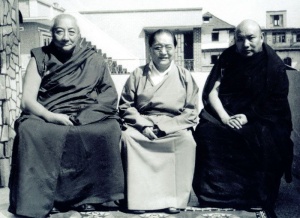
In the 1940’s, both Dudjom Rinpoche and Trulshik Rinpoche spent time in Mindroling, and established strong connections with Minling Khenchen Ngawang Khyentse Norbu and Minling Chung Rinpoche, though it is not year clear if they met at this time.
As shown in the story above on Jamyang Khyentse Rinpoche and Dudjom Rinpoche, Trulshik Rinpoche had already established a connection with Dudjom Rinpoche in the 1956-1959 years in Lhasa, Tibet.
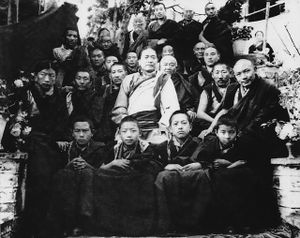
In 1962, in Kalimpong, India, when he was 38 years old only, Trulshik Rinpoche requested and sponsored Dudjom Rinpoche (then fifty-eight) to grant the empowerments, transmissions, and explanations of the whole Nyingma Kama—the Canonical Scriptures of the Ancient Tradition. This historical event — the first ever kama empowerments outside Tibet — enabled many Nyingma practitioners to establish a connection with Dudjom Rinpoche, many on lamas who had leaved in all the corners of Central Tibet, Kham and Amdo, to meet for the first time, and youngers generations practitioners to receive these foundations-like empowerments.
Trulshik Rinpoche also received many empowerments from Dudjom Rinpoche: the Rinchen Terdzö, The Treasury of Precious Hidden Teachings; many other teachings; and especially Dudjom Rinpoche’s own profound termas cycles, such as the Vajrakilaya Pudri Rekpung cycle, The Razor That Destroys at a Touch. With words of praise, Dudjom Rinpoche prophesied that Trulshik Rinpoche would be a Chödak, a custodian, of these terma practice.
In fact, Trulshik Rinpoche became one of the most important expounders of the Dudjom Tersar lineage.
According to Lopön Ogyan Tanzin Rinpoche, Trulshik Rinpoche was one of the two “Vinaya Pillars” of Dudjom Rinpoche, the second one being Taklung Tsetrul Rinpoche, the throneholder of the Dorje Drak Monastery.
A main student of Dilgo Khyentse, and a custodian of one of his terma
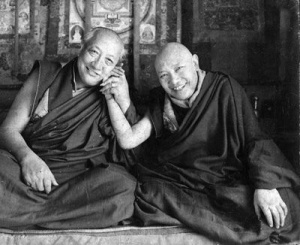
In 1962, in Kalimpong, India, during those very kama empowerments granted by Dudjom Rinpoche, Trsulshik Rinpoche met Dilgo Khyentse for the first time. To forge a first connection, the first teaching he received from him, as a preliminary connection, was the commentary on Nagarjuna's Letter to a Friend. The mutual teacher-disciple relationship they developed over the years was an extraordinary one, the teachings passing from one to the other like the contents of one vase being poured into another. Trulshik Rinpoche received from Dilgo Khyentse Rinpoche received the transmissions for the precious Kangyur, spiritual advice, and a veritable ocean of maturing empowerments and liberating instructions. the whole of Dilgo Khyentse’s own collected teachings and the entire range of Dilgo Khyentsé ‘s termas—and especially his profound terma cycle of Nyak Luk Phurba, Vajrakilaya of Nyak Lotsawa; and many other important collections. In 1977, Dilgo Khyentse Rinpoche visited Thupten Chöling and stayed for several months, giving empowerments such as Gyutrül Shyitro, Nyingtik Yabshyi, Damngak Dzö, The Treasury of Spiritual Instructions; and the Drubtab Küntü, The Compendium of Sadhanas. He practiced these until the minds of teacher and student merged, becoming one. From then on, Trulshik Rinpoche regarded Dilgo Khyentse as one of his principal teachers, a teacher of the definitive meaning. And Trulshik Rinpoche became a heart-son and main holder of Dilgo Khyentse's own collected teachings and lineage. In addition to receiving teachings from him, he offered Dilgo Khyentse some of the rare teachings of which he himself was the holder. This mutual relationship of teacher and disciple was extraordinary, and teachings passed between them like the contents of one vessel poured into another. Dilgo Khyentsé praised Trulshik Rinpoche by honoring him as a Chödak of Dilgo Khyentsé ‘s own terma the Rangjung Pema Nyingtik, The Heart Drop of Padma, or the 'Heart Essence of the Self-Born Lotus' (Tib. རང་བྱུང་པདྨའི་སྙིང་ཐིག་, Wyl. rang byung pad+ma'i snying thig).
Orgyen Topgyal shared the following story,
- Trulshik Rinpoche and Dilgo Khyentse treated each other mutually as master and disciple, with immense respect. As soon as Dilgo Khyentse would see Trulshik Rinpoche, he would immediately prostrate, and on merely hearing Trulshik’s name, he would make the gesture of homage, with his right hand, though I never saw him join his palms. If Trulshik came into the presence of Dilgo Khyentse unannounced and we didn’t all rise and pay respects, Dilgo Khyentse would display displaeasure. Whenever one of us arrived in Nepal while Trulshik Rinpoche was in the Kathmandu Valley, Dilgo Khyentse’s first question was always, “Have you gone to pay respects to Trulshik Rinpoche?” Trulshik Rinpoche always made incredibly generous offerings to Dilgo Khyentse, with countless precious things such as old and valuable statues. I heard once he even offered Thangtong Gyalpo’s personal drinking cup.
- Dilgo Khyentse visited many monasteries in Nepal, and in 1977 he went by helicopter to Solukhumbu. There he gave the empowerments and reading transmissions for the Treasury of Spiritual Instructions, as well as many other teachings, at Trulshik Rinpoche’s seat, Thupten Chöling Monastery. I didn’t have the fortune to accompany him, but later I asked him what it was like there, and he responded, “I found it to be extremely nice. The monastery is not large, but the body, speech and mind representations on the shrine are excellent, and the numerous implements for empowerments are old and very precious. There are many disciples, including pure monks and nuns, and all are genuine practitioners. They live on alms, but the monastic household is prosperous, so at any occasion, even for minor empowerments or sadhana gatherings, they would present lavish feast offerings, including hundreds of butter lamps, tormas an so forth.”
- I was surprised to hear that once when the cook didn’t prepare good food for Dilgo Khyentse, Trulshik Rinpoche slapped him. Trulshik Rinpcohe is an extremely gentle and humble person, always disiplines and careful. In fact I can’t believe that he has even gotten angry, so he must have slapped the cook because of his devotion to his guru was so strong. [10]
Shechen Rabjam shared the following stories,
- It seems that Dilgo Khyentse’w clairvoyance was unimpeded. Once, for instance, Trulshik Rinpoche was coming to visit him in Bhutan. While approaching the Queen Mother’s beautiful palace, Dechen Chöling, Trulshik Rinpoche, who is a most perfect abbot in terms of monastic discipline, remembered a verse from the monastic code that says, “How can we like the king’s palace?” A few moments later, while Trulshik Rinpoche was offering prostrations to Dilgo Khyentse who was staying upstairs in the palace, he heard Dilgo Khyentse say, “Oh, you the good monk keep on saying, ‘How can one like the king’s palace?” but nevertheless you do come to the king’s palace, don’t you?”
- What perhaps surprised me most about this was not so much the fact that Khyentse Rinpoche had read Trulshik Rinpoche’s thoughts, but that when Trulshik Rinpoche told me about it, he was hardly impressed, because for him it was totally obvious and he took it for granted that Khyentse Rinpochhe knew clearly each and every thought of others. So, this wonderful incident also taught me about the degree of pure vision and faith that a great master like Trulshik Rinpoche had in his spiritual teacher.
- Another time, when the Queen Mother had completed the Eight Sadhana Teachings temple in Kurje, Khyentse Rinpoche invited Trulshik Rinpoche to come to Bhutan. During the consecration, Khyentse Rinpoche was sitting on the throne wearing the Guru Rinpoche hat, and Trulshik Rinpoche was sitting to his left wearing the pandita hat. His Majesty the King of Bhutan was sitting to Khyentse Rinpoche’s right wearing his yellow outer robe. The Queen Mother was very devoted to Khyentse Rinpoche and praying to him, and some of the ministers were doing prostrations and circumambulating the mandala and so forth. I felt that even when Guru Rinpoche was consecrating Samye with King Trisong Detsen and Khenpo Shantarakshita, the whole environment was not superior to this. [11]
Granting empowerments all over the world
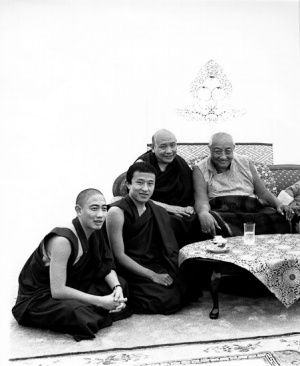
Throughout his life in exile, Trulshik Rinpoche continued to preserve and spreading of the Buddhist teachings and practice, travelling widely in recent years to many countries all over the world, and was seen by many younger lamas of all traditions as a unique figure of reference, his vast learning, his integrity and authenticity, his disarming simplicity, and above all his deep experience and realization, which was unequalled.
While Trulshik Rinpoche was chiefly a master of the Nyingma tradition of Tibetan Buddhism, like Dilgo Khyentse Rinpoche he was aso a perfect example of a Rimé, non-sectarian, teacher. On many existing photographs, he can be seen wearing the hats of the four main lineages of Tibetan Buddhism: Nyingma, Kagyü, Sakya and Gelug. He turned the wheel of the Dharma for many gatherings of the lay and ordained sangha, passing on the kama transmissions of the Nyingma tradition, the Rinchen Terdzö, The Great Treasury of Precious Hidden Teachings, and other maturing empowerments and liberating instructions.
Trulshik Rinpoche was also heir to some of Tibet's rarest traditions, for instance that of Shyijé, the "Pacification of Suffering", first introduced in Tibet during the 11th century by the Indian yogin Padampa Sangye.
As the present embodiment of a line of Tertön, Trulshik Rinpoche continued his predecessor’s teachings, especially those in relations with Guru Rinpoche and Dzogchen. Trulshik Rinpoche conferred the empowerments and teachings for the cycle Dzogchen Yangti Ngapo to several students. Among the recipients were Tulku San-gngak.
Trulshik Rinpoche taught many other great teachers. For example, he was one of Sakya Trizin’s teachers.
After the passing of Dilgo Khyentse, Trulshik Rinpoche became a main source of empowerments for the younger generation of lamas, like Gyalwang Drukchen Rinpoche, Pema Wangyal Rinpoche, Dzongsar Khyentse Rinpoche, Dzigar Kongtrul Rinpoche, Shechen Rabjam Rinpoche, …
Trulshik Rinpoche transmitted the Rinchen Terdzö, The Treasury of Rediscovered Teachings to the Gyalwang Drukchen at Thubten Chöling.
Gyalwang Drukchen Rinpoche recounts:
- I was introduced to Trulshik Rinpoche by Dudjom Rinpoche, saying that I should get the rest of the Dzogchen lineage from him as Trulshik Rinpoche was inseparable from Dudjom Rinpoche himself, meaning that he holds all of the Dzogchen, including the unique lineage of Dudjom Rinpoche.
- When I first went to see him, I travelled anonymously for many days until I reached the site of his monastery where I pitched a tent below the Gonpa. He was in a strict retreat but he sent a monk with a note that said he had been waiting for me as Dudjom Rinpoche had indicated our meeting to him, though he was no longer in this world.
- Trulshik Rinpoche to me was an omnisciently compassionate one, yet his behaviour was that of a completely humble person with no airs of any kind. I do not want to bore you by telling you any more details because this divine master is wonderfully still present in this world and can be known directly by those who have the devotion.
The second time, he gave the complete Nyingtik Yabshyi (the Four Branches of Heart-Essence), the Dam-ngak Dzö (the Treasury of Oral Instructions), the Nyingma Kama (the Canonical Scriptures of the Ancient Tradition), in Nepal at Shechen Monastery for the young tulkus of Dudjom Rinpoche (Dudjom Tenzin Yeshe Dorje) and Dilgo Khyentse (Khyentse Yangsi Rinpoche), and many other lamas and tulkus of all the schools of Tibetan Buddhism.
He completed the transmission of the Druptap Küntü, The Compendium of Sadhanas, and he conferred as well as empowerments from the rediscovered treasures of Kangyur Rinpoche, Dilgo Khyentse Rinpoche and Dudjom Rinpoche.
On one occasion, when he was giving the empowerment of Kangyur Rinpoche’s treasure the Shower of Blessings (Tsikdun Ladrup), which he had himself received from Kyabje Dilgo Khyentse Rinpoche, he remarked that he also felt he had received it directly from Kangyur Rinpoche himself—for when he had first met Kangyur Rinpoche and heard his voice (in Kalimpong, during Dudjom Rinpoche’s Kama teachings), he had, he said, received the blessings of his body, speech and mind, and their minds had merged.
To grant empowerments and give teachings, Trulshik Rinpoche travelled the whole world. He made several trips to Asian countries, including Japan, Thailand, and Malaysia, as well as to the United States. He visited Europe many times, travelling to Spain, Portugal, the United Kingdom, Finland, Belgium and Holland; and in particular he kindly accepted invitations to visit France over many years, and took many practitioners under his care, teaching fortunate students in the closed three-year retreats in Dordogne (France), in the parallel retreat groups, and in public.
People of Sikkim were fortunate to receive his blessings during his visit to Sikkim during the summer of 2007. He performed Rabné of a 135 ft tall statue of Guru Padmasambhava at Samdruptse, Namchi, Sikkim. He also visited the holy lake of Kecheopalri, Drakkar Tashiding.
Offering rare Nyingma teachings to the 14th Dalai Lama
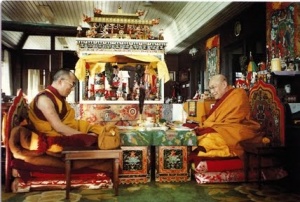
Dilgo Khyentse Rinpoche, over a number of years preceding his parinirvana, had been transmitting to the 14th Dalai Lama a set of important teachings from the Nyingma tradition, including the principal texts of the Mahā, Anu and Ati sections of the inner tantras.
The honour of transmitting whatever remained of these teachings subsequently befell Trulshik Rinpoche, who continued to offer empowerments and teachings to His Holiness, including the Döjo Bumzang, a collection compiled by Minling Terchen Rinpoche (who had transmitted the teachings of the Nyingma tradition to the Great Fifth Dalai Lama), and the major texts of Longchen Rabjampa such as the Ngalso Khorsum, the Seven Treasures, and the Nyingtik Yabshyi. As well as these major teachings from the Nyingma tradition, there were also important Gelugpa teachings, of which Trulshik Rinpoche was the sole holder, which he transmitted to His Holiness. Trulshik Rinpoche had the Nyingtik Yabshyi in Tibet two and a half times: from Shuksep Jetsünma (which was a special lineage he held), from Muktsang Kuchen Rinpoche at Gangri Thökar in front of Longchenpa’s kutsab, from Dudjom Rinpoche and from Dilgo Khyentse Rinpoche. Trulshik Rinpoche was requested to grant the Nyingtik Yabshyi many times, but only did so for the first time very recently when he bestowed it in its entirety upon His Holiness the Dalai Lama.
In 2010, becoming the fifth head of the Nyingma school
In 2010, he became the fifth head of the Nyingma school, succeeding Minling Trichen Rinpoche, who had passed away in 2008.
Building a second monastery in the Kathmandu Valley
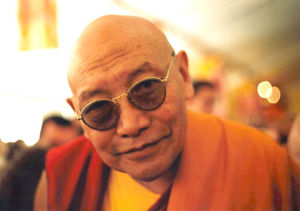
At the end of his life, Truslhik Rinpoche undertook the building of a second monastery, Dzarong Mindrol Thubten Dongak Chöling above Sitapaila, on a hill near Swayambunath in the Kathmandu Valley, Nepal, himself conducting every important ceremony associated with its construction, such as the consecration of the ground, the placing of special vases, images, mantras and yantras within the pillars and beams of the main temple, and so forth. He often stated that his reason for building the monastery was to help remove obstacles in the world in general, and specifically for people throughout the Himalayan region—hence his choice of this particular site, from which can be seen the three important stūpas of the Kathmandu Valley, Swayambhūnāth, Namo Buddha, and Boudhanāth. The hill from the top of which the monastery overlooks the whole valley is associated with the Buddha Vairocana, the nearby hill of Swayambhūnāth associated with Vajrasattva, that of the Tergar monastery associated with Ratnasambhava, the hill of Amitābha behind, and the high, forested hill of Nagarjuna to the north associated with Amogasiddhi.
Identifying the reincarnation of Dilgo Khyentse
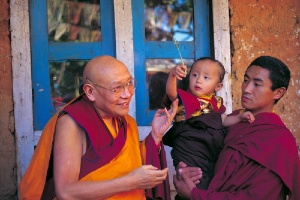
As one of his closest and most senior disciples, Trulshik Rinpoche was responsible for searching, identifying and enthroning the reincarnation of Dilgo Khyentsé.
Shechen Rabjam shared the following story,
- In April, Trulshik Rinpoche had dreamed that he was at Shechen Monastery in Nepal and saw Dilgo Khyentse walking naked out through the door. Trulshik Rinpoche tried to follow him but as unable to get up from his seat. He called through the window, saying, “Rinpoche, please don’t leave us. I want to come with you,” but Dilgo Khyentse could not hear him and left. Trulshik Rinpoche mentioned this dream to Dilgo Khyentse before coming to Bhutan, but Rinpoche merely teased him in response, “Don’t have such strange thoughts. It’s nothing but a dream. Everyone knows that I always go around naked.” After that Trulshik Rinpoche offered an elaborate longevity ceremony. That day I felt exceedingly sad and cried for a long time.
- On the seventeenth, Trulshik Rinpoche arrived. In the morning, Dilgo Khyentse asked us to bring his chair and put brocade on it; he sat on it for a few moments.
- On the eighteenth, when His Majesty the King of Bhutan and Dilgo Khyentse were together, Trulshik Rinpoche arrived and asked, “Do you recognize me?” Khyentse Rinpoche replied, “Of course I recognize that shining head.” While Trulshik Rinpoche looked at Khyentse Rinpoche’s face, Khyentse Rinpoche said, “Shouldn’t I die now?” Trulshik Rinpoche immediately requested him to remain in this world.
- On the nineteenth around one in the morning, Khyentse Rinpoche’s condition worsened. In the morning he asked for a pearl rosary and told Tsewang Lhundrup to do the petition to the Dharma protectors, which is usually not done in the morning. Khyentse Rinpoche had once told me that, before passing away, some lamas request the Dharma protectors to continue their activities.
- Before Dilgo Khyentse left for the hospital, we all offered another longevity ceremony, at which the King of Bhutan was also present. All the tulkus and attendants confessed the faults they might have committed while serving Dilgo Khyentse and pledged to recite a hundred thousand recitations of the Vajrasattva mantra. Dilgo Khyentse then left for the hospital, where he passed away.
- After Dilgo Khyentse passed away, his close students turned to his most senior and accomplished disciple, Trulshik Rinpoche, to find his next incarnation. Trulshik Rinpoche had been having dreams and visions that clearly indicated the identity of his next incarnation. One morning before dawn, he dreamed that twenty-five golden stupas were moving around in the Shechen Monastery courtyard in Bodhnath. Trulshik Rinpoche had only one ceremonial scarf and wanted to offer it to the main stupa but didn’t know which one that was. It clearly occurred to him that these stupas contained the relics of Khyentse Rinpoche. As he was wondering which one was the main stupa, one of them stopped in front of him. A wonderful bird of an unknown species flew out of the window of the upper part of the stupa and began singing. Trulshik Rinpoche came closer and offered a white ceremonial scarf in front of the bird. All twenty-five stupas then lined up behind the first one, as if in a procession, and entered Chökyi Nyima Rinpoche’s monastery Ka-Nying Shedrup Ling.
- In another dream, which was more like a vision—Trulshik Rinpoche humbly said, “It was a dream, but I wasn’t sleeping,”—Khyentse Rinpoche appeared to him and sang a poem revealing the year of the child’s birth, the names of his parents, and the place where he could be found. Trulshik Rinpoche did not want to give too much importance to this vision, but instead of vanishing, the vision became increasingly clear and present in his mind. He kept its details secret until April 1995, when he sent me a letter.
- The search was brief. Decoded, the poem had revealed that the father was his close spiritual friend Tulku Urgyen’s son Tsikey Chokling Migyur Dewai Dorje and the mother was Decheb Paldron. Their son, born on Guru Rinpoche’s birthday, the 10th day of the fifth month of the bird year, June 30, 1993, was, as the verse stated, “unmistakably the incarnation of Paljor’, which was one of Dilgo Khyentse Rinpoche’s name. [12]
Students
Among his students are:
- Dalai Lama
- Dilgo Khyentse Rinpoche
- Dzongsar Khyentse Rinpoche
- Gyalwang Drukchen Rinpoche
- Jigme Khyentse Rinpoche
- Khandroma (based in the US, also a student of Kusum Lingpa)
- Khyentse Yangsi Rinpoche
- Kusho Ngawang Tsephel (his nephew and his chief attendant)
- Lama Ngawang Chophel Gyatso (based in Maratika)
- Pema Wangyal Rinpoche
- Rangdröl Rinpoche
- Soktse Rinpoche (b.1928)
- Tengboche Rinpoche
- Tulku Sang-ngag Rinpoche
Writings
- skyabs rje bde bar gshegs pa 'khrul zhig rdo rje 'chang gi bla sgrub gsol 'debs phyogs bsdus (a collection of guru yoga texts and prayers)
- སྲིད་ཞིའི་རྣམ་འདྲེན་གོང་ས་སྐྱབས་མགོན་རྒྱལ་བའི་དབང་པོ་ཐམས་ཅད་མཁྱེན་ཅིང་གཟིགས་པ་ཆེན་པོ་མཆོག་གི་འཁྲུངས་རབས་གསོལ་འདེབས་བྱིན་རླབས་བདུད་རྩིའི་སྤྲིན་ཕུང་, srid zhi'i rnam 'dren gong sa skyabs mgon rgyal ba'i dbang po thams cad mkhyen cing gzigs pa chen po mchog gi 'khrungs rabs gsol 'debs byin rlabs bdud rtsi'i sprin phung
- ཇོ་བོ་ཐུགས་རྗེ་ཆེན་པོའི་སྔོན་འགྲོའི་འདོན་ཁྲིགས་མུན་སེལ་སྒྲོན་མེ་, jo bo thugs rje chen po'i sngon 'gro'i 'don khrigs mun sel sgron me
- Homage to the Buddhas and Bodhisattvas (རྒྱལ་བ་སྲས་དང་བཅས་པའི་མཚན་ཕྱག་འགའ་ཞིག་མཆོག་དམན་ཀུན་གྱི་ཞལ་འདོན་དུ་བསྒྲིགས་པ་, rgyal ba sras dang bcas pa'i mtshan phyag 'ga' zhig mchog dman kun gyi zhal 'don du bsgrigs pa)
- ཐུགས་རྗེ་ཆེན་པོ་ཡི་གེ་དྲུག་པའི་གསོལ་འདེབས་སྒྲུབ་ཐབས་བྱིན་རླབས་ཅན་, thugs rje chen po yi ge drug pa'i gsol 'debs sgrub thabs byin rlabs can
Trulshik Rinpoche once wrote the following poem addressed to a group of visitors from the Kharta region of Tibet: [13]
- If your mind is pure, everyone is a Buddha.
- If your mind is impure, everyone is ordinary.
- We all wander in samsara by the power of impurity.
- Learn to purify your perceptions, people of Kharta!
Final Years
Well into his eighties, Kyabje Trulshik Rinpoche’s enlightened activity continued tirelessly to benefit the Buddhist teachings and to help all who came into contact with him, with an energy and enthusiasm undiminished by his years. In the last few years of his life, despite his gradually failing health, he continued to give instructions to his disciples both in Asia and in Europe, and was able to spend time at Thubten Chöling monastery to guide the large community of monks, nuns and retreatants there. It was there, just above the monastery, at his residence Phakmai Gatsal (‘the Garden of Noble Tāra’), at his new monastery Dzarong Mindrol Thubten Dongak Chöling, above Sitapaila outside Kathmandu, that finally, on 2 September, 2011, he passed away peacefully at the age of 87.
He remained in Tukdam for three days. The wooden vessel in which lays the kudung of Trulshik Rinpoche, in his inner room, was kept for several days. 200 monks from Shechen Monastery, led by Khyentse Yangsi Rinpoche and Shechen Rabjam Rinpoche performed the ceremonies. The practices made during the 49 days included Guru Yoga and of Avalokiteshvara (the Thukjé Deshek Kundü, a terma related to the Mindroling tradition), the Dakini Tröma Nakmo according to the terma revealed by Nyang Ral Nyima Özer. Everyday, around 50 Lamas, monks and nuns perform a Vajrasattva ceremony in the main room, while hundreds of devotees pray in the garden around the house. At night a few monks take turn to practice Guru Yoga.
Reincarnation
Throughout his whole life, Trulshik Rinpoche always said that his principal practice was based on the verse by Shantideva:
- As long as space endures,
- As long as sentient beings exist,
- So long may I, too, remain,
- To dispel the miseries of this world.
Knowing that this was his main prayer, many of his students recited this prayer after his passing and were confident that he will swiftly return to continue his enlightened activity for the benefit of all beings.
His reincarnation, Ngawang Tendzin Lodrö Rabsel (Tib. ངག་དབང་བསྟན་འཛིན་བློ་གྲོས་རབ་གསལ་), was born in Kathmandu on July 25, 2013 and recognized by HH the Dalai Lama on 9 July 2015. He now resides at Dzarong Mindrol Thubten Dongak Chöling, his monastery in Nepal, where he has started his training and studies.
Visits to the Rigpa Sangha
- 1999: teachings & empowerments
- San Francisco, 1-2 September
- New York, 12 September
- Lerab Ling, 11-14 November
- 2000:
- London, teaching & empowerment, May
- Lerab Ling & Lerab Gar: stays in Lerab Ling and attends His Holiness the Dalai Lama's teachings
- Rigpa centre, Levallois, 7 October
- 2003: teachings & empowerments
- Lerab Ling, 23 June-3 July
- Kirchheim, 28-31 December
- 2005: teachings & empowerments
- Lerab Ling, 1-10 December
For more details, see Empowerments Given to the Rigpa Sangha
Notes
- ↑ Trulshik Rinpoche ‘s different names include Ngawang Chokyi Lodro (Primary name), Dzarong Truklshik Ngawang Chokyi Lodro Rinpoche (Personal name), Kunzang Trinlé Drodul Tsal (Secret initiatory name), Trulshik Rinpoche Ngawang Chökyi Lodrö, Dzarong Trulshik Shatrul Ngawang Chokyi Lodrö.
- ↑ Nyoshul Khenpo, A Marvelous Garland of Rare Gems: Biographies of Masters of Awareness in the Dzogchen Lineage (Junction City: Padma Publications, 2005), pages 352-353.
- ↑ Dilgo Khyentse, The Life and Times of Jamyang Khyentse Chökyi Lodrö, Shambala Boulder, 2017, p203.
- ↑ Nyoshul Khenpo, A Marvelous Garland of Rare Gems: Biographies of Masters of Awareness in the Dzogchen Lineage (Junction City: Padma Publications, 2005), pages 352-353.
- ↑ Dilgo Khyentse, The Life and Times of Jamyang Khyentse Chökyi Lodrö, Shambala Boulder, 2017, p197.
- ↑ Dilgo Khyentse, The Life and Times of Jamyang Khyentse Chökyi Lodrö, Shambala Boulder, 2017, p197.
- ↑ It was probably Phuntsok Podrang Ngawang Kunga Thutop Wangchuk (1900-1950).
- ↑ Stephen Venables, Everest Summit of Achievement, Royal Geographical Society, London, Ted Smart, 2003, p64.
- ↑ See Counsels from My Heart, Dudjom Rinpoche, page 31.
- ↑ Dilgo Khyentse Rinpoche, Brillant Moon The Autobiography of Dilgo Khyentse, Shambala Boston & London, 2018, p219.
- ↑ Dilgo Khyentse Rinpoche, Brillant Moon The Autobiography of Dilgo Khyentse, Shambala Boston & London, 2018, p291.
- ↑ Dilgo Khyentse Rinpoche, Brilliant Moon The Autobiography of Dilgo Khyentse, Shambala Boston & London, 2018, p219.
- ↑ Richard J. Kohn, Lord of the Dance The Mani Rimdu Festival in Tibet and Nepal, State University of New York Press, 2001, p7.
Accounts of Trulshik Rinpoche's Life
- Sogyal Rinpoche, Rigpa Berlin Centre, 30 September 2011
Further Reading
In Tibetan
- Ngagyur Nyingma College, འོག་མིན་ཨོ་རྒྱན་སྨིན་གྲོལ་གླིང་གི་གདན་རབས་མཁན་བརྒྱུད་རིམ་པར་བྱོན་པ་རྣམས་ཀྱི་རྣམ་ཐར་གཡུལ་ལས་རྣམ་པར་རྒྱལ་བའི་དགའ་སྟོན་, 'og min o rgyan smin grol gling gi gdan rabs mkhan brgyud rim par byon pa rnams kyi rnam thar g.yul las rnam par rgyal ba'i dga' ston, Ngagyur Nyingma College, 2002, pp. 187-189
In English
- Hugh R. Downs, Rhythms of a Himalayan Village, Delhi: Book Faith India, 1996
- Nyoshul Khenpo, A Marvelous Garland of Rare Gems: Biographies of Masters of Awareness in the Dzogchen Lineage (Junction City: Padma Publications, 2005), pages 352-353.
- Rigpa Journal, September 2000, 'Kyabjé Trulshik Rinpoche'
Internal Links
- Mani Rimdu
- Mount Everest
- Prayer for the Long Life of Trulshik Rinpoche by His Holiness the Dalai Lama
- Trulshik Rinpoche's Lineage of Nyingtik Yabshyi
- Trulshik Rinpoche's previous incarnations